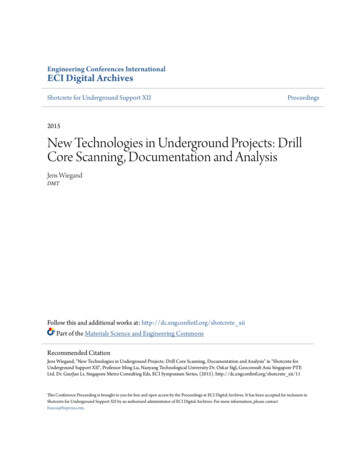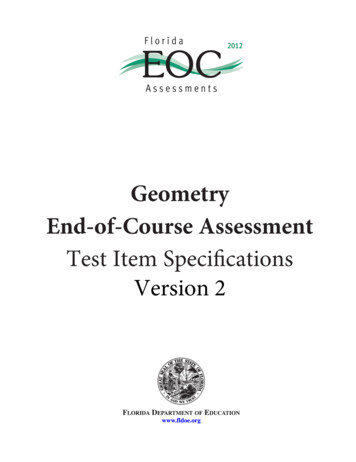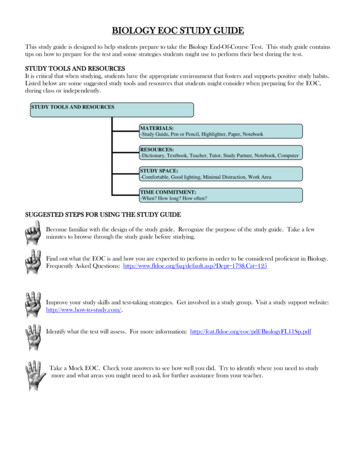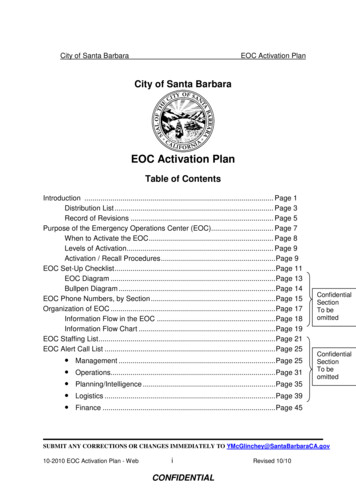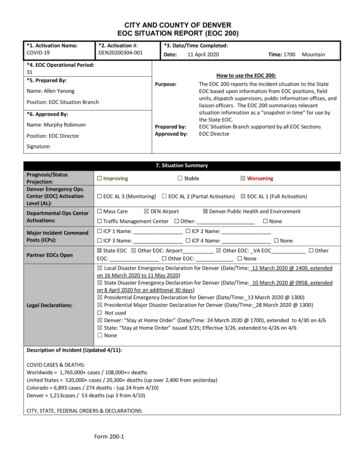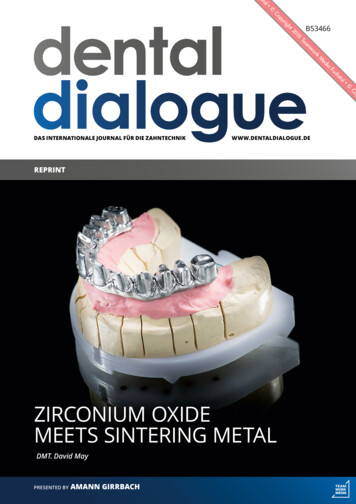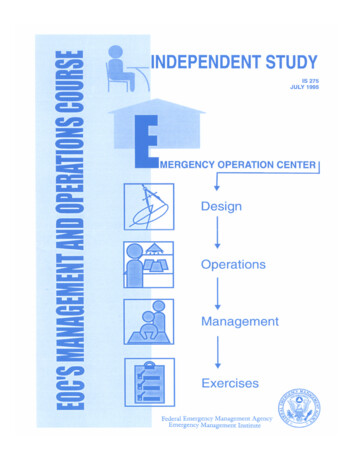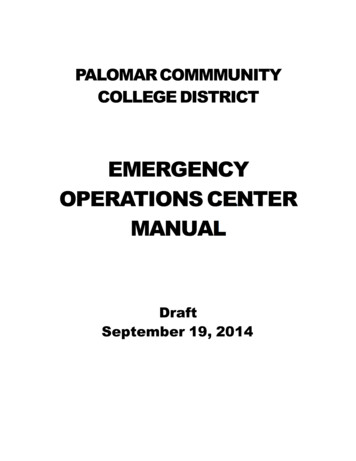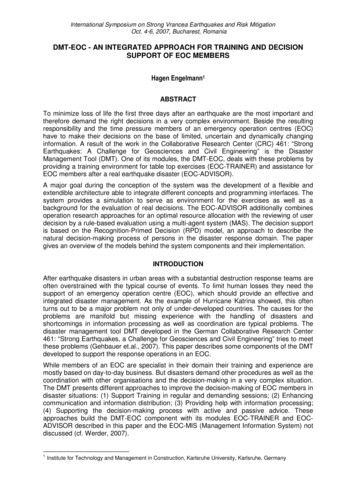
Transcription
International Symposium on Strong Vrancea Earthquakes and Risk MitigationOct. 4-6, 2007, Bucharest, RomaniaDMT-EOC - AN INTEGRATED APPROACH FOR TRAINING AND DECISIONSUPPORT OF EOC MEMBERSHagen Engelmann1ABSTRACTTo minimize loss of life the first three days after an earthquake are the most important andtherefore demand the right decisions in a very complex environment. Beside the resultingresponsibility and the time pressure members of an emergency operation centres (EOC)have to make their decisions on the base of limited, uncertain and dynamically changinginformation. A result of the work in the Collaborative Research Center (CRC) 461: “StrongEarthquakes: A Challenge for Geosciences and Civil Engineering” is the DisasterManagement Tool (DMT). One of its modules, the DMT-EOC, deals with these problems byproviding a training environment for table top exercises (EOC-TRAINER) and assistance forEOC members after a real earthquake disaster (EOC-ADVISOR).A major goal during the conception of the system was the development of a flexible andextendible architecture able to integrate different concepts and programming interfaces. Thesystem provides a simulation to serve as environment for the exercises as well as abackground for the evaluation of real decisions. The EOC-ADVISOR additionally combinesoperation research approaches for an optimal resource allocation with the reviewing of userdecision by a rule-based evaluation using a multi-agent system (MAS). The decision supportis based on the Recognition-Primed Decision (RPD) model, an approach to describe thenatural decision-making process of persons in the disaster response domain. The papergives an overview of the models behind the system components and their implementation.INTRODUCTIONAfter earthquake disasters in urban areas with a substantial destruction response teams areoften overstrained with the typical course of events. To limit human losses they need thesupport of an emergency operation centre (EOC), which should provide an effective andintegrated disaster management. As the example of Hurricane Katrina showed, this oftenturns out to be a major problem not only of under-developed countries. The causes for theproblems are manifold but missing experience with the handling of disasters andshortcomings in information processing as well as coordination are typical problems. Thedisaster management tool DMT developed in the German Collaborative Research Center461: “Strong Earthquakes, a Challenge for Geosciences and Civil Engineering” tries to meetthese problems (Gehbauer et.al., 2007). This paper describes some components of the DMTdeveloped to support the response operations in an EOC.While members of an EOC are specialist in their domain their training and experience aremostly based on day-to-day business. But disasters demand other procedures as well as thecoordination with other organisations and the decision-making in a very complex situation.The DMT presents different approaches to improve the decision-making of EOC members indisaster situations: (1) Support Training in regular and demanding sessions; (2) Enhancingcommunication and information distribution; (3) Providing help with information processing;(4) Supporting the decision-making process with active and passive advice. Theseapproaches build the DMT-EOC component with its modules EOC-TRAINER and EOCADVISOR described in this paper and the EOC-MIS (Management Information System) notdiscussed (cf. Werder, 2007).1Institute for Technology and Management in Construction, Karlsruhe University, Karlsruhe, Germany
International Symposium on Strong Vrancea Earthquakes and Risk Mitigation433This paper discusses the advantages of computer-based training sessions and how softwaretools can help decision-makers by systematically supporting their decision-making process.It starts with an overview of the system architecture and then discusses the use of the EOCTRAINER component for exercises. The main part deals with the decision supportcomponent EOC-ADVISOR describing the integration of the computer-based support in ahuman decision-making process.SYSTEM ARCHITECTUREThe system is designed to allow the arbitrarily addition and removal of componentsdepending on its usage. While the simulation is used for decision support as well as training,there is a clear distinction between the real world and simulation. Everything connected tothe real world is implemented in the agent environment. Anything covering the simulatedworld runs in the simulation environment. A special Mediator Agent establishes theconnection between simulation and agents and steers the simulation.Figure 1. The system architectureThe architecture of DMT-EOC can be divided into three elements: simulation, decisionsupport and a user interface for the human computer interaction (HCI) (Figure 1). Themodular and distributed design of all elements of the system allows an easy integration ofnew functionalities and configuration for different tasks. To ensure the interoperability of thesystem components, the system provides a common database to store static and dynamicdata as well as an XML-based standard format for information exchange DMT-IXS (DMTInformation Exchange Standard). Especially the DMT-IXS format allows an easy integrationof external components based on different programming languages or developmentframeworks.DMT-IXS format defines an XML Schema (XSD) a data format and rules encoding ofinformation. It integrates the ideas of different XML-based communication standards fordisaster management, namely MayDayML in the MESA Project (www.projectmesa.org) andCAP (Common Alerting Protocol) and EDXL (Emergency Data Exchange Language) fromthe OASIS (www.oasis-open.org) consortium. DMT-IXS has some differences and
434H. Engelmannextensions to these standards but the integration of a system based on these standards caneasily be made. As all system components of the DMT use the DMT-IXS format, agentsreceive the same type of message from a response resource, regardless if it is simulated ora real-world resource. This ensures interoperability with non-agent based systems like theField Unit Expert System or the Simulators.AgentsThe agent environment is implemented as a multi-agent system (MAS). Its frameworkfollows the FIPA Agent Management Specification (www.fipa.org), which defines thephysical infrastructure for an Agent Platform (AP) in which agents can be deployed andconsist. The Agent Management System (AMS) is mandatory for every AP. It hassupervisory control over the access and use of the AP and offers white pages services toother agents. Additionally, the Directory Facilitator (DF) provides yellow pages services soagents may register their services with the DF or query the DF to find services offered byother agents. There are three types of agents: Interface Agents are responsible for the human-computer interaction and visualize theresults of the simulation and the advice of the decision support agents. Depending ontheir task they have different capabilities. While the EOC agents include a geographicinformation system (GIS), an interface for the decision support and a messaging tool, theagents for field units only consist of the messaging tool for receiving orders and sendingreports. Each Mediator Agent represents a simulation in a multi-agent environment. It translatesmessages from the agent to the simulation environment and vice versa. The MediatorAgent sends a message from a simulated response resource in the same format as aninterface agent of a real world resource would do. Therefore, simulated and realresources can be mixed for training applications. A Proxy Agent doesn’t translatemessages but receives and sends them in the XML-Format of the DMT. Its only task is todistribute messages between different environments, e.g. the FIPA-ACL environmentand an E-Mail service. The Decision Support Agents are response-related and combines the Belief-DesireIntension (BDI) concept with an inference engine. The BDI approach was very muchinfluenced by Bratman (Bratman, 1987) and software agents following this paradigmhave been applied successfully to different real world problems such as the faultdiagnosis for the space shuttle or air-traffic management (Ingrand et al., 1992). A BDIagent pursues its given goals (desires), adopting appropriate plans (intentions) accordingto its current set of data (beliefs) about the state of the world. An inference engine usesexpert knowledge stored in a rule base (or knowledge base) with inference rules. Basedon these rules information about the current situation is analysed by forward chaining, anapproach typically used in expert systems (Jackson, 1999). The rule base and the planlibrary are based on the analysis of emergency plans and standard operation proceduresas well as expert surveys. Depending on the input an agent chooses to process it (1) byan elementary layer including methods for information which can be handled directly, (2)a planning layer including plans and rules which are solely based on the agent’sdeliberation and (3) a co-operation layer which handles situations that requires coordination with other agents. The currently implemented decision support agents forEOC members can be seen in Figure 2. They provide their advice as a kind of servicewhich can be inquired by a human decision-maker by the Interface Agents. The DecisionSupport Agents continuously evaluate the situation in the disaster environmentautonomously to keep track of the dynamic changes, even without interaction with ahuman.
International Symposium on Strong Vrancea Earthquakes and Risk Mitigation435As described later these three agent types collaborate to provide the decision support ofEOC members.SimulationThe simulation reproduces the dynamic aspects of the disaster world and the responseoperations of the resources. It is realised by an interaction between resource simulators andenvironment simulators, e.g. fire fighting is an interaction between the fire simulator and thefire brigade simulator. The platform of the simulation environment is the High LevelArchitecture (HLA).Figure 2. The system architectureHLA was developed by the Defense Modeling and Simulation Office (DMSO) of Departmentof Defense (DoD) with the main goal of building a platform for war gaming and training takinginto account the interoperability and reuse of different simulation components. It is anapproved platform for distributed simulations and since 2000 an Institute of Electrical andElectronics Engineers standard. For each simulation the Run Time Infrastructure (RTI)provides the central service for the interaction of the simulators. These services include, forexample, management, data distribution or time management. The RTI defined is the centralcomponent of an HLA-based simulation which transfers all communication flow between thesimulators (for more details see Institute of Electrical and Electronics Engineers (IEEE)(IEEE, 2000). HLA is mainly considered a standard for simulation-based military training(Lolar 2002; Sjöström et al., 2003). Nevertheless, some simulators for comparable fields likelogistics (Reyns et al., 1998), emergency medical treatment (Pettitt et al., 1998) or naturalenvironment modelling (Gerrard et al., 1999) have been developed. More recently therehave been increasing efforts to apply HLA to civilian domains, such as traffic and logistics(Strassburger, 2001) or emergency management (Klein, 2001). In the simulationenvironment two types of simulators can be distinguished, the environment and the resourcesimulators.The disaster environment simulators provide a realistic representation of the area struck by adisaster. Broadly speaking, they describe how the disaster situation would proceed if nofurther response activities were initiated. These simulators have complete knowledge of theactual situation including, for instance, real damage states of buildings or health states ofinjured and trapped persons. Therefore, the world resulting from these simulators can bespecified as the Complete Information World (CIW): The earthquake simulation EQSIM is based on the capacity-spectrum-method (Fiedrich,2002) to estimate building damages, which provide the input for training scenarios orinitial damage estimation after real disasters for an EOC.
436H. Engelmann The casualty simulator models the health state of injured persons. The initial health statedepends on the location of a person in a collapsed building and is decreased dependingon the state of the rescue operation, e.g. if the person is trapped (Coburn et al., 1991),rescued or on the way to a hospital. The Fire simulator uses an approach comparable to Takai (Takai, 1999) consisting ofthree physical models which calculate (1) the way fire spreads within a burning building,(2) the possibility of neighbouring buildings catching fire and (3) the extinguishingprocess from fire fighting (Torvi et al., 2001).The resource simulators consist of federates for air and ground reconnaissance, SARteams, fire fighting units, construction machinery for road clearance and support for SARteams and ambulances for the transport of the injured persons (see Figure 2). As thesimulators represent units in the field they have limited access to the information provided bythe environment simulators. Each single resource has a sight radius in which it can sensethe disaster world at a specific resolution. The assignment of tasks to the resources can onlybe initiated by external stimuli such as orders by EOC members. The subsequent operationssuch as movement and resource work at the assigned areas are simulated within theresource simulators according to technical specifications (for more details see Fiedrich et al.2000).The resulting information from the simulators combined with a pre-disaster database leads toan Incomplete Information World (IIW). This mimics a real disaster situation for members ofEOC during an exercise. It is needless to say that the evaluation of user decisions during areal disaster is based on the information of the CIW, while the results of such simulations arestill very uncertain because the initial information for such a simulation already represents anincomplete view to the real disaster situation.EOC EXERCISEThree different types of exercises for EOC members can be distinguished. (1) Table topexercises are run by a facilitator and they usually have a master event list. This listcomprises more or less independent general problem statements and the participantsdiscuss possible actions without time pressure. (2) Functional exercises are used to testone or more emergency functions in real time. Therefore, the input is made via messagesand the consequences of the decisions are estimated by experts located in separate rooms.Exercises of these two types are inexpensive but the main problem is the limited dynamicsfor dealing with unforeseen actions and the need for rational and scientifically sound experts.(3) Real time field exercises are more realistic because they include field personnel as wellas EOC staff. The communication flow and the participants are the same as in a realdisaster. Although very realistic, these exercises are rather rare, because they are veryexpensive and time consuming in preparation. Therefore, virtual training for emergencyresponse is getting more and more popular, but its application is far from common (Jain,2003). The use of dynamic, virtual environments has, however, been part of military trainingfor some time.Exercise with the DMTThe EOC-TRAINER provides a virtual training environment for real time exercises of anEOC. By replacing missing field personnel with simulated response units it generates avirtual real time exercise without having the need of a full scale exercise. The majoradvantage is the universal facility of mixing real world and simulation during the trainingexercises. Because field exercises are very expensive fewer real teams will be practicingduring a typical exercise, normally not enough to stretch the members of an EOC like itwould be in a real disaster situation. For such cases additional resource simulators must beadded to make the experience more realistic. So the EOC members can train their
International Symposium on Strong Vrancea Earthquakes and Risk Mitigation437communication with real humans and also practice their decision-making under realisticconditions.The integration of exercise and disaster response like in DMT-EOC also bears practicaladvantages. From an economical point of view it is cheaper to be able to integrate trainingabilities in an existing system for disaster response. In addition the user acceptance for asystem will be much higher if they already know it from practical exercises instead of havingto take special courses for it. The adaptability of a system also allows its use in day-to-daybusiness and regular use of a software system ensures its steady advancement andmodification to current necessities.DECISION SUPPORT FOR EOC MEMBERSDecision-making during disasters is marked by key features like dynamic conditions,uncertain and missing data, time pressure and the need for real-time reaction, ill-definedtasks and goals as well as significant consequences for mistakes. The EOC-ADVISORsupports the planning process of EOC personnel during the response phase. Typicalfunctions of EOC members include a huge variety of different responsibilities such as thedeclaration of a local emergency, dissemination of emergency information to the public,resource tracking, etc. The advice functions of the agents are more or less related to thetopic of resource management. Beside the presentation of the techniques used in EOCADVISOR the following section will review the current range of realistically applicablecomputer-based decision support for disaster management from the authors’ view.Decision-making in disaster managementTo build a decision support system for an EOC it should fist be considered how humansmake their decisions to understand what needs they may have. Taking a look at differentmodels describing human decision-making processes in command and control (C2)environment two approaches can be identified. The first ones are analytical modelsdescribing decision-making as an analytical process where the problem and/or differentsolutions are analysed in detail to find a proven optimal result. Examples for this approachare the Multi-Attribute Utility Analysis (MAUA) and the Decision Analysis. The second onesare recognitional strategies in which the decisions are based on the application of theexperience of the decision-maker with similar situations. The Recognition-Primed Decision(RPD) model can be assigned to this type (Klein, 1997).To choose the right support for the decision-makers in an EOC it has to be determined whichmodel matches their decision-making strategy. As Klein developed the RPD based on theexperiences of commanders in the fireground environment it seems that this matches thesituation after an earthquake. But as the situation in an EOC does not seem as stressful asin the field, it could be assumed that an analytical process is also possible. What speaks infavour of the use of the RPD model is the stress resulting from the time pressure in which asolution must be found and from the responsibility for many lives. In additional, the decisionmakers in an EOC are generally former field commanders and therefore they are used tothis decision-making process. Both facts have been approved in interviews with EOCmembers and personnel of a training facility for disaster management in Germany.Decision-makers in an EOC are usually domain experts with many years of experience. Butthe management of an extensive disaster like a major earthquake will most likely be a taskthat exceeds their abilities. Computer systems could be used to provide adequate support.To see which specific tasks need to be supported, the following section will describe theRPD model before discussing where computers can assist decision-makers and can help toimprove the quality of decisions.
438H. EngelmannRPDThe RPD model is based on the assumption that domain experts make decisions withoutperforming rather time-consuming analyses. Instead they rely on their ability to recogniseand classify a situation. Based on this they are able to find a matching workable and efficientsolution in a timely manner. Especially time is an important factor in decision-making afterdisasters because acting too late may result in an out-of-control situation and have a directimpact on the number of victims. So time is a key feature for the design of the decisionsupport system. Figure 3 shows the RPD model. It consists of two parts: recognition andevaluation.Figure 3. The RPD modelIn the recognition phase the decision-maker tries to develop situational awareness and torecognise similar events. If no instant match can be found further diagnosis of the situation isneeded. The model states two typical strategies for this, feature matching and story building.In the feature match the decision-maker tries to match the information describing the currentsituation with pattern of cues from his experience. If matches found are inadequate, due tothe lack of experience or a unique situation, story building strategies may help to constructan explanation. The observed cues of the current situation are coherently linked together.This builds sets of hypothetical stories in the mind of the decision-maker which are thencompared to the observed events to find the most probable explanation.The recognition process has four results: (1) Relevant cues are identified in the recognitionphase and describe what to pay attention to in the recognised situation. (2) Based on thesituation there are plausible goals which should or could be achieved. (3) A course of actionsis recognised which will reach the goals. (4) Expectancies about what should change inwhich way and what should happen. The expectancies serve as a way to monitor whethercurrent recognition is still reasonable. Changes in the environment or new information couldlead to the result that the current chosen recognition might not match the situation and hasto be changed or modified. To clarify such an anomaly the diagnosis has to be repeated as itis influenced by the changing parameters and the input of new information.Before the course of action defined by the recognition can be implemented the decisionmaker tests it. He mentally simulates the actions and their possible results. If this evaluationof the actions shows resolvable problems he modifies them and tests again. In case of asevere mismatch the decision-maker might chose a different course of action based on the
International Symposium on Strong Vrancea Earthquakes and Risk Mitigation439current recognition or he examines a new one. The evaluation process only checks forplausibility (“Does it works?”) and not for quality (“How well does it works?”), a point where acomputer system may improve this evaluation.Depending on the complexity of the problem steps in the recognition or evaluation areskipped. If the situation is directly recognised and the reaction is obvious, we have a simplematch in which the recognition and evaluation are left out and the course of actions isimplemented directly. Another possibility is that the decision-maker instantly recognises asimilar situation but has to modify his solution slightly. In this case he skips the recognitionand develops the course of action by modifying the solution in the evaluation phase.Computer based decision supportAfter taking a look at the human decision-making the question remains how computers cansupport this process. Agent technologies enable the design of software that can reasonautonomously (Boden, 1994) and thus provide an opportunity for intelligent decision support.There are a number of approaches which try to apply agent technology to areas relevant toemergency response, including earthquake disaster response (Tadokoro et al., 2000), forestand bush fire firefighting (Au, 2000; Jaber et al., 2001) and flood management (Molina andBlasco, 2003). The RPD model was also the starting point for several research approaches.Liang (Liang et al., 2001) used neural networks to represent experiences during the featurematching process. There are also attempts to use agent technologies in combination withthe RPD model to simulate human behaviour (Sokolowski, 2003) or to provide support fordecision-making in teams (Yen, 2005).So far these approaches are not able to improvise on given situations and can’t replace ahuman as decision-maker during a real disaster. Beside the fact that orders from computerswill not be easily accepted by humans, there are problems in the interaction between manand machine. Especially between the domains involved in disaster managementmisunderstandings due to different terms and abbreviations is a typical problem. In additionso far the scope of computer systems is limited to specific problems and can not be adaptedto unforeseen situations. Going back to the RPD modelling all aspects of decision-making fora specific domain create the need to compile huge knowledge bases. Especially themodelling of the story-building aspect seems to be a problem because as till now a machinecannot match a human in the ability to improvise and adapt to a new situation.Following all this, it does not seem reasonable to replace a human decision-maker orelements of his decision-making by currently available software. This fact is supported bydiscussions of the author with decision-makers in the emergency response which identifiedtwo potential sources of problems with computer-based support systems:1. Blind trust: Users accept a system and develop a blind trust in its advice. A simpleexample is the experience in control centres for fire brigades in Germany. Depending onthe keywords extracted from a situation description the system automatically generates acombination of response units based on the standard operating procedures. In mostcases these suggestions are accepted without further consideration. This may beappropriate for most situations but may also result in inefficient decisions because thesystem does not have access to or does not consider all facts.2. Missing acceptance: Others users do not accept computers in general or do not trust intheir ability to provide help. Possible causes for this are that they are not used to workingwith computers or they have experienced ill-designed systems. Apart from this the ideathat computer systems may replace humans is often present. Therefore, in order toensure user acceptance, it is important to introduce computer-based support carefullyand step by step.
440H. EngelmannAs a conclusion to what is technically feasible and what is reasonable from the practicalpoint of view, it seems clear that a decision support system for an EOC shouldn’t providesolutions that a human can implement directly. Instead, EOC-ADVISOR supports the phasesof the decision-making process. The RPD model serves as a guideline for elements thatneeds to be supported as well as their order and interdependencies. As this includes variedtasks, different types of interaction models are used ranging from active advice giving to amore passive criticising or an evaluation of decisions.Decision support based on the RPD modelTo decide what should be supported the strengths as well as the weaknesses of computersand humans have to be considered. In general, computers are unbeatable in computingpower for well structured problems and they are uninfluenced by feelings. Humans incontrast are far better at improvising and adapting to unknown situations by relying more orless on their feelings and instincts.The situation in an EOC seems predestined for an extensive computer-based support ascomputer systems could easily being provided in most cases. Command centres oftenalready have special rooms equipped with or prepared for computer systems and evenmobile command centres e.g. in trucks existing. Beside this a computer system providesinformation EOC members would need anyway like a map to review the situation and amessaging system for communication. If such software is accepted it is a small step tosimple decision support components providing automatic processing of incoming informationand more complex systems giving advice to users or evaluating their decisions.Figure 4. Decision support based on the RPD modelIn the DMT-EOC the EOC-MIS provides a user interface with messaging, map support aswell as context sensitive information filtering. It builds the foundation for the interface of theEOC-ADVISOR. Its concept is to support the user according to the phases of a decisionmaking process based on the RPD model. Figure 4 gives an overview of the methods usedin the EOC-ADVISOR. While it focuses on the resource allocation during responseoperations after earthquakes it could easily be adapted to other disasters and tasks as well.
International Symposium on Strong Vrancea Earthquakes and Risk Mitigation441RecognitionThe requirements for support during the recognition phase depend on the time that haspassed after the initial disaster event. While the first hours are affected by the uncertaintyabout the situation, an overflow of incoming information is the major problem later on.To deal with the initial uncertainty a simulation of the disaster is useful. Earthquakeparameters available minutes after the earthquake event can be used to calculate initialdamage estimates. The EQSIM component of the DMT provides a classification of theexpected damages for each single building (Baur et al., 2001). Based on this information theplanning process for the resource allocation can start earlier and planning of reconnaissanceoperations can be optimised. When the load of incoming information increases filtering andinformation processing techniques support the user. The elect
modular and distributed design of all elements of the system allows an easy integration of . system components, the system provides a common database to store static and dynamic data as well as an XML-based standard format for information exchange DMT-IXS (DMT- . (CIW) : The earthquake simulation EQSIM is based on the capacity-spectrum .
